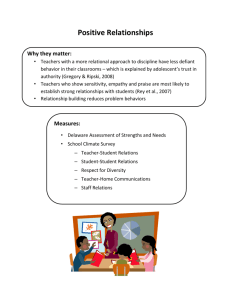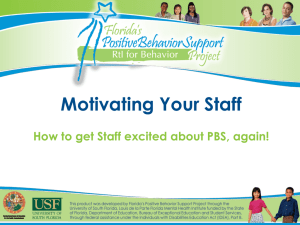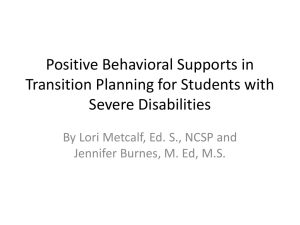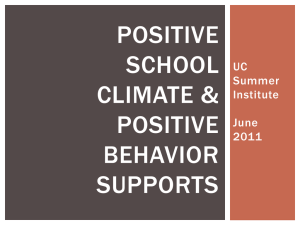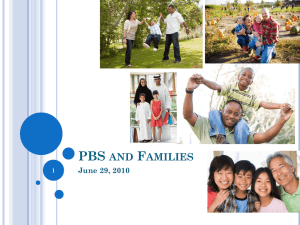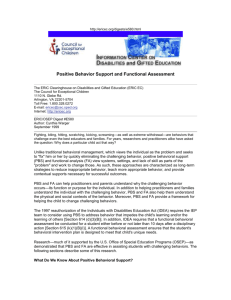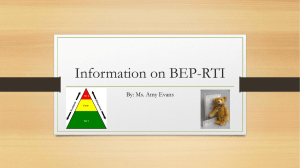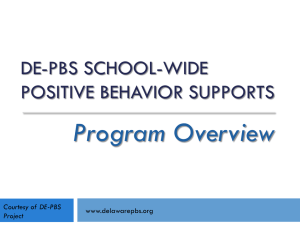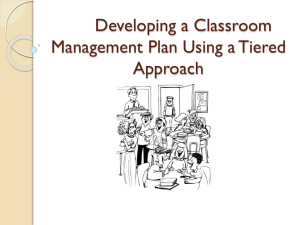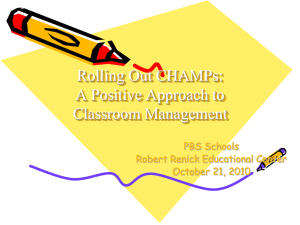Positive Behavioral Supports (PBS)
advertisement
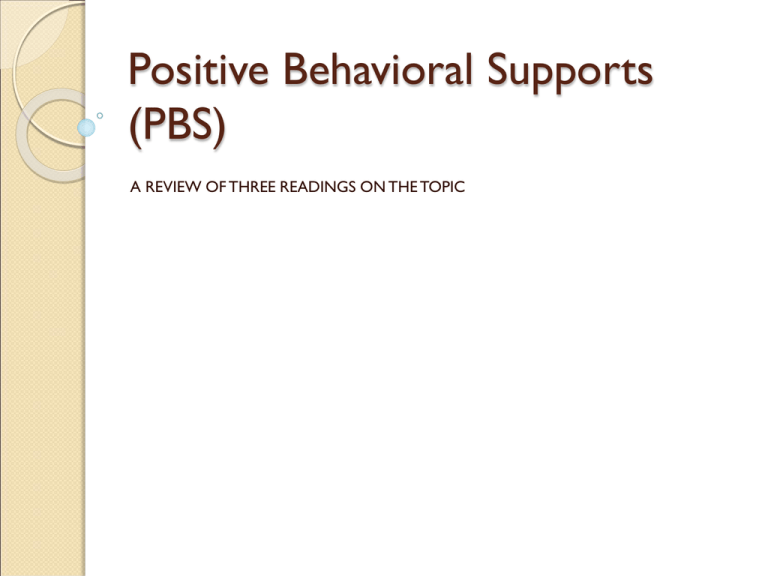
Positive Behavioral Supports (PBS) A REVIEW OF THREE READINGS ON THE TOPIC Technical Guide Sugai, et al (1999). Applying positive behavioral support and functional behavioral assessment in schools. Washington, D.C.: OSEP Center on Positive Behavioral Interventions and Support. Internalizing Problems Externalizing Problems Social Withdrawal Depression Anxiety Somatization Hyperactivity Aggression Antisocial Destructive Internalizing Vs. Externalizing Problems in Schools Students with severe problem behaviors ◦ 1% - 5% of the school enrollment ◦ More than 50% of behavioral incidents Schools often lack the following: ◦ Staff trained in behavior management or PBS ◦ Behavioral/ Emotional Curricula ◦ Assessment methods to monitor behaviors Effective Schools (Tier I) Policies and procedures (written down) Structure (trained faculty and staff) Routines (child knows what to expect) Research-validated practices Community Schools School-linked services Community providers come into the schools. Families are a part of the intervention process. Inter-connected web of services PBS: Defined Positive Behavioral support is a general term that refers to the application of positive behavioral interventions and systems to achieve socially important behavior change. Extends from individual interventions to school-wide services. Services are research-based and closely monitored PBS: Defined, Part II Interventions consider the contexts within which the behavior occurs. Interventions that address the functionality of the problem behavior. Interventions that can be justified by the outcomes. Outcomes that are acceptable to the individual, the family, and the supportive community. Integration of Approaches Behavioral Science: problem behaviors are learned, can be controlled within the environment and can be changed. Practical Interventions: Research-based techniques such as FBA, environmental redesign, and skills instruction are used. Lifestyle Outcomes: Change must be durable, relevant, culturally appropriate, and fit the values of the student, family, and community. Systems Perspective: All systems levels must be considered (Bronfenbrenner) to be effective. Interventions must be continued across settings. PBS: Focus on Prevention Primary: Reducing the number of new cases of problem behaviors. Secondary: Reducing the number of current cases of problem behaviors. Tertiary: Reducing the intensity and complexity of current cases. FBA Within PBS Data Collection: antecedent (A), behavior (B), consequence (C), and environmental issues. Testable Hypotheses: Establish theories of reasons for behavior. Direct Observation: Collect data Design Behavior Support Plan: should address the A, B, and C as well as environment. Develop Implementation Scripts: how, when, where, etc of implementation. Collect Information: student progress, plan implementation, redesign/ update the plan, efficacy of the plan. Designing PBS Bambara, L. M., & Knoster, T. (1998). Designing Positive Behavior Support Plans. In. D. Browder (Ed.) Innovations. Washington, D.C.: American Association on Mental Retardation Assess What Areas? Student Strengths & Weaknesses Daily Routines & Activities Student & Family Preferences and Goals Health Concerns Quality of Life ◦ ◦ ◦ ◦ ◦ Relationships Happiness Choice and Control Access to Preferred Events School & Community Inclusion Gather Information Where? Team Discussions Interviews Review of Records Rating Scales Specific Skill Assessments Direct Observations Gather Broad Information Questions to Answer When is the individual most likely to engage in problem behavior? What specific events appear to be contributing to the problem behavior? What function(s) does the problem behavior serve? What might the individual be communicating through the behavior? When and what type of situation is the behavior less likely to happen? Tools for Gathering Information Direct Observations ◦ Team Discussions of Observed Situations ◦ ABC Analysis ◦ Compare activities and time periods for those that are more or less problematic Gather Specific Information Specific Hypothesis Statements Purpose ◦ Offer a logical explanation for the problem behavior. ◦ Guide the development of the plan Examines the Following: ◦ When this happens . . . (a description of the specific antecedent and setting event) ◦ The student does this . . . (a description of the behavior). ◦ In order to . . . (a description of the possible function of the problem behavior). Global Hypothesis Statements Summarize: ◦ Relevant assessment information ◦ Contextualized assessment information Addresses: ◦ Broad influences of health, skills, routines, quality of life, and preferences. ◦ Contextual explanation for the behavior. What Next? Based on the global and specific hypotheses, you generate a plan of action. The plan may include: ◦ ◦ ◦ ◦ ◦ ◦ System-wide changes (Tier I) Environmental changes (Tier I) Skills training (Tier II) Group Therapy (Tier II) FBA (Tier III) Individual Therapy (Tier III) School-Wide Changes: PBS Nelson, R., & Sugai, G. (1992). School-wide application of positive behavioral supports. In G. Sugai and T. J. Lewis (Eds.) Developing Positive Behavioral Support of Students with Challenging Behaviors. Roseville, MN: The Council for Children with Behavioral Disorders. Possible Problems in the Environment Lack of clear and consistent behavioral guidelines. Poor supervision Inadequate curriculum and teaching practices Other organizational practices. School-Wide PBS Systematic Change Multi-Level ◦ Building ◦ Classroom ◦ Student Establishing the Committee Eight or fewer members Broad representation across the system. One member knows ABA/ FBA 2- to 3- year term of appointment with only 25% of team rotating off annually Committee Will . . . Attend all planning meetings. Identify key presenting problems. Conduct a site analysis. Develop/ revise the school-wide PBS program. Evaluate new or revised components of the school-wide PBS program. Actively communicate with staff members regarding the activities of the committee. Conduct staff meetings to ensure the implementation and maintenance of the schoolwide PBS. Stages of Collaborative Problem Solving for School-Wide PBS Problem Definition (What are the problems?) Site Analysis (What is currently in place to address the problems?) Development of a School-Wide PBS Plan (What should be done to monitor the problems?) Monitoring Progress (Did the school-wide PBS program work?) Stage One: Problem Definition Multiple Data Sources: ◦ ◦ ◦ ◦ Parents Teachers Administrators Support Staff Methods: ◦ Surveys/ questionnaires ◦ Interviews ◦ Direct Observations Stage Two: Site Analysis Four systems to be analyzed: ◦ School-wide discipline system ◦ Specific settings or non-classroom systems (e.g., hallways, bathrooms, library, lunchroom, etc.) ◦ Classroom systems ◦ Individual student support systems (highintensity students) Stage Three: Development of PBS Develop a draft proposal describing changes (pros and cons). Present draft to all individuals for discussion. Allow time for feedback and comments. Revise the proposal Present the final proposal to staff for approval Supervise the implementation of the system Stage Four: Monitoring Progress Make evaluation procedures simple. Allow for immediate staff feedback. Compare current information back to baseline data collected previously during the stage one. Share evaluation findings with the school. Adjust school-wide PBS as needed.
